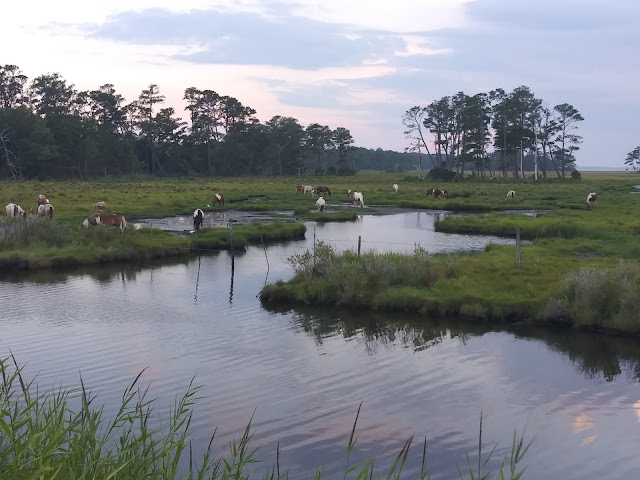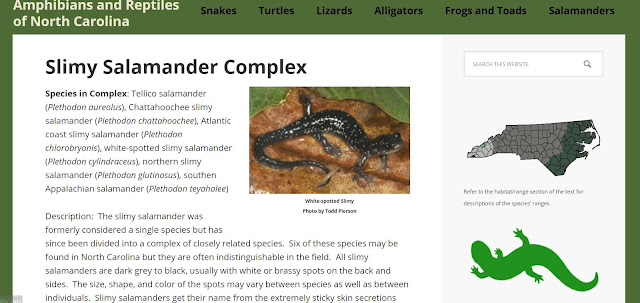Freshwater Marshes and Wild Ponies
July 18, 2019
Today's adventure took us through the freshwater marshes and into Assateague beaches. The smell was everything the Park Rangers told me it would be. Very different from the tidal saltmarshes, here it smelled like stale algae and swamp. The grasses here grew shorter and looked soft and velvety. There were pine trees and lots of swamp roses. And of course, there were the ponies. A good portion of the herd had come closer to the edge of their fenced-in area to graze. Alongside them were larger gatherings of egrets.
As we moved further down the road the smell grew stronger and the color of the water grew stranger. My interview with the Park Ranger prepared me for what I was observing. Throughout the summer breeding months, the rangers create deeper water pools using artificial dams. This helps to trap rain waters for the summer birds who depend on deeper waters and allows the rangers to drain them for the winter migratory birds. It was about 7:00pm when we passed through this area on our bicycles. A perfect hour as we out of the blistering 101-degree temperatures.
Our late evening cruise was rewarded with the site of the majestic blue heron standing as still as a statue in one of the pools mentioned above.
Closer to Assateague Island beaches the freshwater pools changed to black. This was because of the pine needles that fell into the water and made the waters more acidic. It is not something we noticed at first, because the change is sudden as you pass a grassy patch that hides a dam. But it is remarkable once you look closer. I'm sure not everyone notices as they drive by in their cars and mopeds. But I am very appreciative of Laurel, the Park Ranger, whom I interviewed earlier, and explained the methods they used to control water flow on the conservation lands. Just as sudden as the waters turned black, they were back to being milk chocolate on the other side of the dam.
The views grew more and more beautiful and abounded with more waterfowl. Ducks had gathered to waddle through the shallow mud in search of bugs and worms.


We noticed how the sky was changing into a painted masterpiece as the distance haze, thunder and lightning were brewing across the bay.
Still, Assateague Beach was a sight to behold and historical as well. This thin strip of sandy beach would soon be gone and off-limits to visitors. Regular storm surge and tidal flooding has quickly eroded this area away. Plans have been in the works for a few years and now the conservation agencies are closer to a plan to move this popular beach destination six miles down from where we were standing. I stood in the middle of the sandy strip. Beautiful pastels streaked the sky on my right over the Atlantic, while the flaming sunset behind the trees and marshes of Chincoteague.
I'll let you enjoy the scene as I did while absorbing this beautiful moment. I must say, please note how the sky is lit up above the clouds in various degrees of brightness in spite of the setting sun. So magnificent.
I moved closer to the Atlantic side of the beach to get better views of the water. The beach disappears into the horizon. This is the direction of the beach we explored yesterday. It is away from the freshwater marshes and is where the future of this beach location will reside.
We were miles away from safety and the lightning was getting closer, so we swiftly peddled back to our hotel.
But not before snapping a few more sunset photos over the freshwater marshes.
Chincoteague truly is a beautiful place. The rest of my stay will be relaxing and enjoying the closeness with nature and frigid waters with my best travel partner who has thoroughly enjoyed riding the trails, finding new creatures to examine up close and laughing wildly as I fight off hoards of mosquitoes to get fabulous pictures. It seems my insect repellent is not working as well as I had hoped with the sunblock and sweat in this humidity, but we managed only a few lumpy bites.
What I see here in this wonderfully complex ecosystem on the conservation, is successful conservation tourism and education. Assateague has a visitor center as well as the Chincoteague end of the island. There is a respect for nature and this resource shared with everyone. I didn't mention it earlier, but car travel around the Nature Reserve trails is restricted during parts of the day, large sections of the beach are also closed to the public to protect the nesting birds, and many folks have rented electric vehicles to drive around town and onto the reserve. We still found the most enjoyable trek was to simply bike our way around the island and every end of the Nature Reserve.
Although I complain about the mosquitoes, which really are plentiful, I am aware that they too have a place in the grand scheme of things in nature. There are no measures taken to control the mosquitoes as it is unknown how using such insecticides may harm other insects and bugs on the reserve. Conservation efforts are everyone's responsibility and that is very evident amongst everyone I observed coming and going and enjoying this wonderful resource. It is a shame this level of respect and responsibility does not abound everywhere.
Today's adventure took us through the freshwater marshes and into Assateague beaches. The smell was everything the Park Rangers told me it would be. Very different from the tidal saltmarshes, here it smelled like stale algae and swamp. The grasses here grew shorter and looked soft and velvety. There were pine trees and lots of swamp roses. And of course, there were the ponies. A good portion of the herd had come closer to the edge of their fenced-in area to graze. Alongside them were larger gatherings of egrets.
Our late evening cruise was rewarded with the site of the majestic blue heron standing as still as a statue in one of the pools mentioned above.
Closer to Assateague Island beaches the freshwater pools changed to black. This was because of the pine needles that fell into the water and made the waters more acidic. It is not something we noticed at first, because the change is sudden as you pass a grassy patch that hides a dam. But it is remarkable once you look closer. I'm sure not everyone notices as they drive by in their cars and mopeds. But I am very appreciative of Laurel, the Park Ranger, whom I interviewed earlier, and explained the methods they used to control water flow on the conservation lands. Just as sudden as the waters turned black, they were back to being milk chocolate on the other side of the dam.
 |
| Vegetation has grown up around the artificial dam separating the freshwater pools. |
The views grew more and more beautiful and abounded with more waterfowl. Ducks had gathered to waddle through the shallow mud in search of bugs and worms.
 |
| Yes, those are ducks across the street in the water. |


We noticed how the sky was changing into a painted masterpiece as the distance haze, thunder and lightning were brewing across the bay.
 |
| A storm is brewing across the bay. |
 |
| Just to the left of the storm, one of the prettiest sunsets glows. |
Still, Assateague Beach was a sight to behold and historical as well. This thin strip of sandy beach would soon be gone and off-limits to visitors. Regular storm surge and tidal flooding has quickly eroded this area away. Plans have been in the works for a few years and now the conservation agencies are closer to a plan to move this popular beach destination six miles down from where we were standing. I stood in the middle of the sandy strip. Beautiful pastels streaked the sky on my right over the Atlantic, while the flaming sunset behind the trees and marshes of Chincoteague.
 |
| Standing in the middle of the parking lot facing the Atlantic. |
 |
| Facing the opposite, in the direction of the setting sun...and approaching storm. You can get a sense for just how thin this stretch of beach is. |
 |
I'll let you enjoy the scene as I did while absorbing this beautiful moment. I must say, please note how the sky is lit up above the clouds in various degrees of brightness in spite of the setting sun. So magnificent.
I moved closer to the Atlantic side of the beach to get better views of the water. The beach disappears into the horizon. This is the direction of the beach we explored yesterday. It is away from the freshwater marshes and is where the future of this beach location will reside.
We were miles away from safety and the lightning was getting closer, so we swiftly peddled back to our hotel.
But not before snapping a few more sunset photos over the freshwater marshes.
Chincoteague truly is a beautiful place. The rest of my stay will be relaxing and enjoying the closeness with nature and frigid waters with my best travel partner who has thoroughly enjoyed riding the trails, finding new creatures to examine up close and laughing wildly as I fight off hoards of mosquitoes to get fabulous pictures. It seems my insect repellent is not working as well as I had hoped with the sunblock and sweat in this humidity, but we managed only a few lumpy bites.
What I see here in this wonderfully complex ecosystem on the conservation, is successful conservation tourism and education. Assateague has a visitor center as well as the Chincoteague end of the island. There is a respect for nature and this resource shared with everyone. I didn't mention it earlier, but car travel around the Nature Reserve trails is restricted during parts of the day, large sections of the beach are also closed to the public to protect the nesting birds, and many folks have rented electric vehicles to drive around town and onto the reserve. We still found the most enjoyable trek was to simply bike our way around the island and every end of the Nature Reserve.
Although I complain about the mosquitoes, which really are plentiful, I am aware that they too have a place in the grand scheme of things in nature. There are no measures taken to control the mosquitoes as it is unknown how using such insecticides may harm other insects and bugs on the reserve. Conservation efforts are everyone's responsibility and that is very evident amongst everyone I observed coming and going and enjoying this wonderful resource. It is a shame this level of respect and responsibility does not abound everywhere.

















Comments
Post a Comment